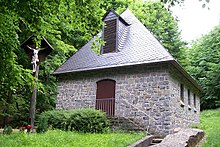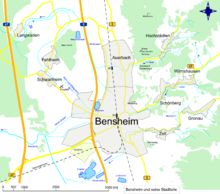In need of God (Auerbach)
The chapel Zur Not Gottes , often referred to as the Not-Gottes-Kapelle , stands northeast above Auerbach, a district of Bensheim an der Bergstrasse in the south of Hesse , at the end of the valley in the front Odenwald .
Geographical location
The Chapel Zur Not Gottes is located from Darmstädter Straße (B3) following the Ernst-Ludwig-Promenade uphill, between the Melibokus and the Auerberg with the Auerbach Castle . Shortly before the pass of both mountains it can be found hidden in the forest on the left of the road.
history
It can be assumed that in the first half of the 13th century, probably in place of the hermitage "Zu den Einsiedeln" from the 11th to 12th centuries, the Counts of Katzenelnbogen in the vicinity of their Auerberg Castle (Auerbach Castle) built a large one Pilgrimage church with the miraculous image of the praying Savior on the Mount of Olives was built. This Not-Gottes-Kirche was at the same time a spring sanctuary for the nearby “Not-Gottes-Brunnen”, whose magnesium-containing spring was taken as a well. The older hermitage was initially a wooden building with a threshold beam construction. With the construction of the pilgrimage church, a two-room, large post structure was erected above the hermitage, which served as a residence for the hermit who was in office as chaplain. In the northern ring wall of the Auerbach Castle there was the so-called “Pfaffengang”, through which the chaplains of the chapel climbed steeply and directly to the castle chapel in order to hold the service there. From Auerbach a pilgrim path led up to the chapel from the west, from which a supply path branched off shortly before, which led from the southwest to the chapel.
Around 1370/80 the simple late Romanesque hall church with a retracted rectangular choir and five altars was given a richer interior and a massive extension on the southern nave wall, which was also used for residential purposes.
In 1427 still called “To the Einsiedeln”, the name “Zur Not Gottes” was created in the middle of the 15th century, presumably after the installation of a miraculous image with the depiction of the Mount of Olives, on which Christ's fear of death was made visible.
The catchment area of the pilgrimage “In need of God” extended from the northern reed to the northern Odenwald. In the course of the Reformation introduced by the Landgraves of Hesse , the successors of the Katzenelnbogen family, the church lost its function and between 1528 and 1557 it was demolished except for a few remains of the wall.
It was not until the 19th century that the church tradition revived in the form of forest services and in 1896 the Not-Gottes-Fest was brought to life at the old pilgrimage site. In 1893, Countess Marie von Erbach-Schönberg donated a nearly life-size crucifix carved in Oberammergau by the art school of Mayor Lang, and Grand Duke Ernst Ludwig donated a bell made in the Heun foundry in Frankenthal, which was initially hung between two trees in 1903. It was removed again after the First World War. The not insignificant regional importance of the Not-Gottes-Pilgrimage is well documented for the late Middle Ages.
New building
Remnants of the wall were first excavated in 1891/92 on the initiative of Auerbach pastor Karl Eigenbrodt by the district sergeant major Heinrich Gieß from Heppenheim, who was well versed in monument conservation. In 1893, the facility, which was uncovered in its foundation walls, was prepared by Professor Adamy from Darmstadt and the Bensheim master builder Lucius.
Between 1958 and 1960 the Christian partnership "Brothers of Common Life" (Stuttgart-Weilimdorf) rebuilt the chapel according to plans by the Augsburg architect and Bavarian state church builder Schatz. The result was a simple, rectangular hall church made of Sonderbach granite (near Heppenheim ), the hipped roof facing west and a gable roof for a bell, with rectangular window openings on the long sides, the entrance in the west can be reached via an outside staircase. The simple church building stands on the foundation walls of the choir of the pilgrimage chapel, which has only been preserved in the remains of the wall.
In 1991 excavations took place again, which provided further information. The remains of the foundation wall of the old chapel in front of today's chapel were restored after the excavations were completed and are the last valuable evidence of medieval religiosity. The new chapel is a humble document from the late 1950s.
Today an ecumenical open-air service is held at the chapel every year on Ascension Day by the Catholic and Protestant parishes of Auerbach.
In 2010 the Evangelical Church Community of Bensheim-Auerbach set up an urn cemetery at the chapel, which has been in use since mid-2010. The chapel is also available for funeral ceremonies or weddings within the framework of the cemetery statutes and the fee schedule. The parish office is responsible for relevant information.
Certificate
A document dated June 26, 1427 states:
Count Johann IV. Von Katzenelnbogen declares that, with the knowledge of the local chaplain Wilhelm, he received 100 guilders from the Auerbach chapel in order to replace the eleven guilders that Count Johann's grandfather (anich) gave to Werner Kalb from the count's bed Reinheim has sold. Since the Auerbach chaplain does not have enough pensions to have his own food in his house, the count grants him food in the castle in honor of Mary and all the saints from now on forever. For this purpose, all Auerbach chaplains should read a weekly mass on Saturdays in honor of Mary and pray for the parents of the Count and his wife, for Count Wilhelm and his parents, for the exhibitor and his wife and their son and his wife, and pray for their salvation. However, the other masses with which the chapel was initially endowed should not be forgotten. Wilhelm improved the structure and property of the Auerbach Chapel for as long as he owned it; In particular, he gave 60 guilders for a vineyard and handed it over to the aforementioned chapel with the stipulation that every chaplain in Auerbach should take three priests to himself, namely the pastor in Auerbach, the early knife there and the chaplain in Einsiedeln, so that they can while The aforementioned Auerbach chaplain on Sunday reminiscere a vigil with nine lessons in the evening and on Monday morning after that reads a soul mass for all believers, read three soul masses with him in the Auerbach parish church in order to share with all the deceased ancestors of the count and their wives as well as those of his wife and to commemorate his daughter-in-law as well as the deceased Count Gerhard, Provost of Speyer, and Count Wilhelm and his parents and siblings and all who have ever done him good. For this purpose, the aforementioned chaplain is to receive 1/2 gulden annually from Weingülte and give the other three priests four shillings each on Monday after Reminiscere and keep the other Gülte for themselves. It should stay here forever. If the vineyards are redeemed one day, the 60 guilders paid for it must be safely invested elsewhere with the knowledge of the counts. If the designated priests are unable to attend these Reminiscere masses, the Auerbach chaplain can, with the consent of the Auerbach pastor, take other priests, so that there are always four in total.
literature
- Dieter Griesbach-Maisant et al .: District Bergstrasse I. (= monument topography Federal Republic of Germany , cultural monuments in Hesse .) State Office for Monument Preservation Hesse, Wiesbaden 2004, ISBN 3-8062-1905-2 , pp. 357-359.
Web links
- State Office for the Preservation of Monuments Hesse (ed.): Chapel To Not God In: DenkXweb, online edition of cultural monuments in Hesse
- Noth-Gottes Chapel, Bergstrasse district. Historical local dictionary for Hessen. In: Landesgeschichtliches Informationssystem Hessen (LAGIS).
Individual evidence
- ↑ Not-Gottes-Feast on Ascension Day. In: Bergsträßer Anzeiger , edition of April 25, 2008
- ↑ odenwald.de: Not-Gottes-Kapelle ( Memento from October 26, 2007 in the Internet Archive )
- ↑ Congregational Letter July-Oct. 2010 (information in the parish office, Bachgasse 39, 64625 Bensheim-Auerbach, phone: + 49-6251-71184) (PDF; 2.3 MB)
- ↑ Homepage of the responsible parish
- ↑ Demandt, Regesten der Grafen von Katzenelnbogen, Regesten-Nr. 3346 (HStAD inventory B 3 No. 274). In: Archive Information System Hessen (Arcinsys Hessen).
Coordinates: 49 ° 42 ′ 51 ″ N , 8 ° 38 ′ 7 ″ E



